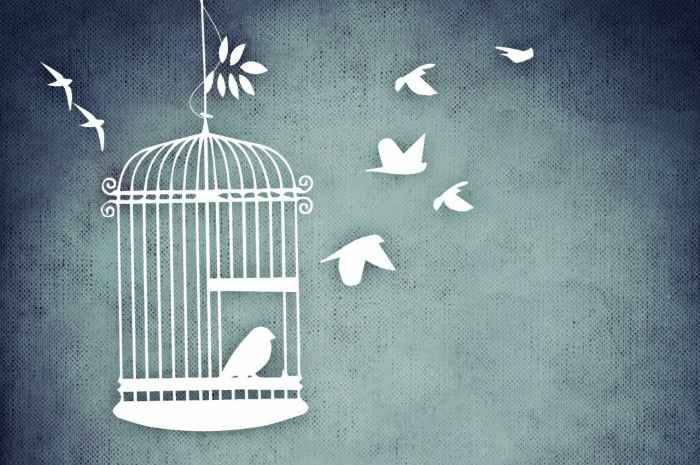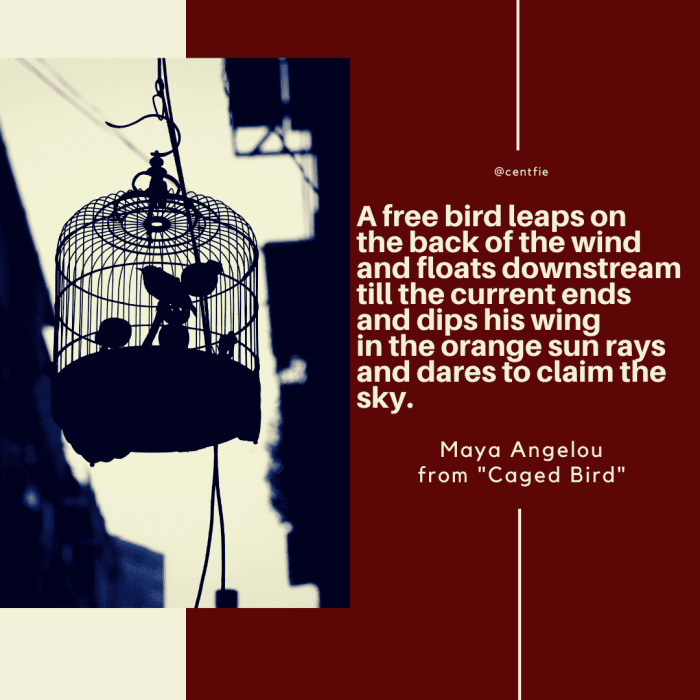Analysis of the Poem "Caged Bird" by Maya Angelou
"Caged Bird" Poem Overview
Maya Angelou’s poem titled "Caged Bird" was inspired by Paul Dunbar’s poem "Sympathy." The major theme of both poems is freedom.
Angelou's autobiography I Know Why the Caged Bird Sings exemplifies the meaning of this poem.
In the book, she explores the struggle of being black, a woman, and an author. Living in America then, she felt like a slave and that her voice wasn't being paid attention to.
The Free Bird and the Caged Bird
The free bird can fly, walk, and see the outside world. The caged bird can't do all these. He can only sing.
The free bird seems too busy to sing, as he has more pleasures to enjoy. He takes his freedom for granted. He doesn’t know what being caged means. Yet, his ignorance of oppression and slavery is his strength.
Perhaps, through the song of freedom, the person who caged the bird will tire of his constant songs and set him free. Thus, his voice is his weapon.
Unlike the free bird who “leaps on the back of the wind,” “floats” and “dips,” and “claims the sky,” the cage restricts the abilities of the caged bird.
Nonetheless, he keeps his freedom of expression and uses it. The bird expresses himself through singing. He is still alive, and despite being a prisoner, he can still use his voice. His throat is free. He sings so loudly that his voice reaches the "distant hill."
Even though he is in a cage, there’s no lock or cage that can restrict his voice and freedom of mind.
Who hears the song of the caged bird? Does he sing for his benefit? Does he sing to the person who put him in a cage? Does he sing out of boredom or because he loves to sing?
The Structure
Stanzas and Lines
The poet positioned the stanzas based on emotions, themes, and mechanical patterns. The poem has 6 stanzas and 38 lines. The first and fourth stanzas have a happy tone and the rest are morose.
The poet grouped stanzas with similar patterns in the following pairs: Stanza 1 and 2 (7 lines), Stanza 3 and 6 (8 lines), Stanza 4 and 5 (4 lines).
It's quite interesting how this adds musicality to the poem and creates a rhythm. The poem reads like music. It's like a song with a chorus and a bridge.
Hence, "Caged Bird" can qualify as a lyrical poem.
Meter
"Caged Bird" is a free verse poem with some iambic metrical pattern. Iambs are two syllables whereby an unstressed syllable is followed by a stressed syllable. If you read aloud you will realize the rising intonation from the unstressed to the stressed syllable.
Recommended
Example:
Iambic meter:
A free bird leaps (unstressed-stressed)
There is also anapest:
on the back of the wind (unstressed-unstressed-stressed)
The fourth line is a combination of anapest and an iamb.
till the current ends.
Rhyme
The rhyming scheme in "Caged Bird" is irregular since it doesn't follow an obvious pattern.
The end rhymes include these words:
cage—rage
trill—still—hill
breeze —trees
lawn—own
dreams—scream
An example of internal rhyme:
dawn—lawn (line 25, stanza 4)
Diction
The poet expresses human life through meaningful word choices that elicit different emotions and tones. For instance: freedom, dawn, sings, wind, leaps and free bird depict happiness and enthusiasm.
On the other hand, the words: caged bird, trill, grave, shadow, and rage imply sadness and powerlessness.
The Persona and Characters
The poem "Caged Bird" seems to stem from personal experience. However, he uses the pronoun "he" to refer to the bird.
The author’s choice of the second person pronoun “he” and thus the third person pronoun “his” instead of the feminine to describe the bird's song.
The persona is observing the birds and reflecting their lives to his own.
9 Literary Devices in the "Caged Bird" Poem
1. Metaphor
The hidden message in the poem is that it is not about a bird, but a person.
The title is a metaphor. Also, the line "the caged bird sings" is a metaphor.
It suggests more than what the meaning of the words first glances. There is a deeper meaning to the poem. This poem is not about birds, but mankind.
The dreams of the caged bird represent the dreams of the slave. The bird sings of “things unknown/ but longed for still.”
Things unknown to the caged bird are enjoyed by the free bird. Free people seem to have everything and live life to the fullest.
The action of the caged bird to choose to sing is also a metaphor. Music is often beautiful and enjoyable. But his state of being caged is despicable. However, when he sings of freedom perhaps someone will hear his voice and open the cage.
2. Imagery
The speaker creates vivid imagery through descriptive words and phrases. Imagery enhances the theme and tone of the poem.
The speaker sees the physical appearance of the caged bird. It is locked in a cage and cannot fly because his "wings are clipped and his feet are tied." So, it stalks around. It shows the lack of freedom of the bird.
Then, the imagery of the free bird that leaps and floats develops the theme of freedom and a joyful tone.
The persona describes the surroundings and the actions of the birds: “Orange sun rays,” "fat worms," "dips his wing," "opens his throat."
These descriptions give the reader an image of the natural beauty and the actions of the birds in the setting.
3. Juxtaposition
The poem compares two birds in different situations. Slavery is in contrast to freedom. The caged bird and the free bird have different points of view.
Each bird expresses diametrically opposite emotions and actions. The free bird is joyful and energetic, in contrast, the caged bird is sad and lethargic.



